Desa VSGF36NTA, VSGF36PRA, VSGF36NRA, VSGF36PTA User Manual
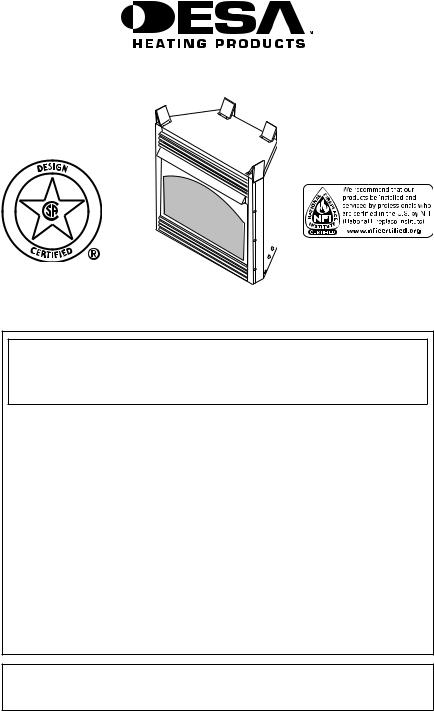
UNVENTED (VENT-FREE) GAS FIREPLACE SYSTEM OWNER’S OPERATION AND INSTALLATION MANUAL
MODELS
VSGF36NTA, VSGF36PTA, VSGF36NRA AND VSGF36PRA
WARNING: If the information in this manual is not followed exactly, a fire or explosion may result causing property damage, personal injury or loss of life.
—Do not store or use gasoline or other flammable vapors and liquids in the vicinity of this or any other appliance.
—WHAT TO DO IF YOU SMELL GAS
•Do not try to light any appliance.
•Donottouchanyelectricalswitch;donotuseany phone in your building.
•Immediatelycallyourgassupplierfromaneighbor’s phone. Follow the gas supplier’s instructions.
•If you cannot reach your gas supplier, call the fire department.
—Installationandservicemustbeperformedbyaqualified installer, service agency or the gas supplier.
INSTALLER: Leave this manual with the appliance. CONSUMER: Retain this manual for future reference.
For more information, visit www.desatech.com
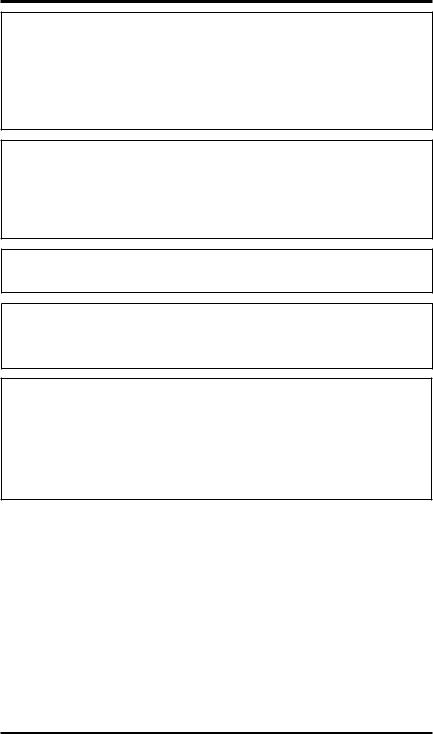
WARNING: Improper installation, adjustment, alteration, service or maintenance can cause injury or propertydamage.Refertothismanualforcorrectinstallation and operational procedures. For assistance or additional information consult a qualified installer, service agency or the gas supplier.
WARNING: This is an unvented gas-fired heater. It uses air (oxygen) from the room in which it is installed. Provisions for adequate combustion and ventilation air must beprovided.RefertoAir for Combustion and Ventilation section on page 7 of this manual.
WARNING: For use only with a listed decorative type unvented room heater. Do not build a wood fire.
ThisfireboxhasbeentestedandapprovedbyCSAInternational under Z21.91-2001 for use with approved ANSI Z21.11.2 decorative type unvented room heater.
This appliance may be installed in an aftermarket*, permanently located, manufactured (mobile) home, where not prohibited by local codes.
This appliance is only for use with the type of gas indicated on the rating plate. This appliance is not convertible for use with other gases.
*Aftermarket: Completion of sale, not for purpose of resale, from the manufacturer
TABLE OF CONTENTS
Safety Information ............................................... |
3 |
Cleaning and Maintenance |
................................ |
25 |
Local Codes ........................................................ |
4 |
Wiring Diagram.................................................. |
|
26 |
Product Identification........................................... |
5 |
Specifications .................................................... |
|
26 |
Unpacking ........................................................... |
5 |
Replacement Parts............................................ |
|
26 |
Product Features................................................. |
5 |
Technical Service .............................................. |
|
26 |
Locating Firebox.................................................. |
6 |
Service Hints ..................................................... |
|
26 |
Product Specifications......................................... |
6 |
Troubleshooting................................................. |
|
27 |
Air For Combustion and Ventilation..................... |
7 |
Accessories....................................................... |
|
31 |
Installation ........................................................... |
9 |
Illustrated Parts Breakdown .......and Parts List |
32 |
|
Operating Fireplace........................................... |
19 |
Warranty Information........................... |
Back Cover |
|
Inspecting Burners ........................................... |
24 |
|
|
|
2 |
www.desatech.com |
116746-01A |
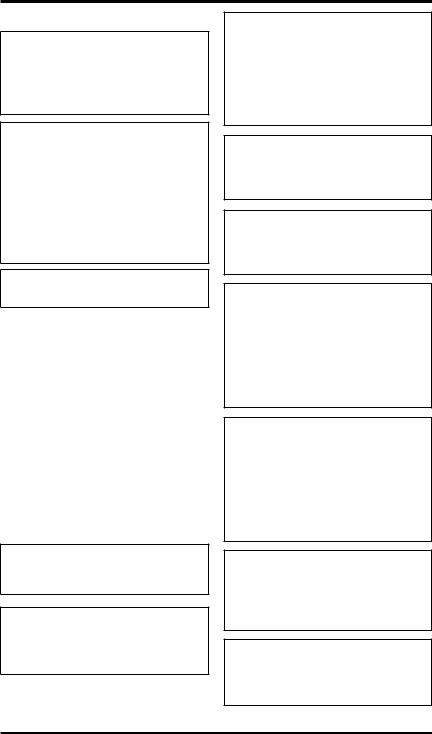
SAFETY INFORMATION
 WARNING:Thisproductcontainsand/orgenerateschemicals known to the state of California to cause cancer or birth defects or other reproductive harm.
WARNING:Thisproductcontainsand/orgenerateschemicals known to the state of California to cause cancer or birth defects or other reproductive harm.
IMPORTANT: Read this owner’s manualcarefullyandcompletely before trying to assemble, operate or service this heater.
Improper use of this heater can cause serious injury or death from burns, fire, explosion, electrical shock and carbon monoxide poisoning.
 DANGER: Carbon monoxide poisoning may lead to death!
DANGER: Carbon monoxide poisoning may lead to death!
Carbon Monoxide Poisoning: Early signs of carbon monoxide poisoning resemble the flu, with headaches, dizziness or nausea. If you have these signs, the heater may not be working properly. Get fresh air at once! Have heater serviced. Some people are more affected by carbon monoxide than others.Theseincludepregnantwomen,peoplewith heart or lung disease or anemia, those under the influence of alcohol and those at high altitudes.
Natural and Propane/LP Gas: Natural and pro- pane/LPgasesareodorless.Anodor-makingagent isaddedto the gas.Theodorhelps youdetecta gas leak. However, the odor added to the gas can fade. Gas may be present even though no odor exists.
Makecertainyoureadandunderstandallwarnings. Keep this manual for reference. It is your guide to safe and proper operation of this heater.
 WARNING: Any change to this heater or its controls can be dangerous.
WARNING: Any change to this heater or its controls can be dangerous.
 WARNING: Do not use a blower insert, heat exchanger insertorotheraccessorynotapproved for use with this heater.
WARNING: Do not use a blower insert, heat exchanger insertorotheraccessorynotapproved for use with this heater.
 WARNING: Do not allow fans toblowdirectlyintothefireplace. Avoidanydraftsthatalterburner
WARNING: Do not allow fans toblowdirectlyintothefireplace. Avoidanydraftsthatalterburner
flame patterns. Ceiling fans can create drafts that alter burner
flame patterns. Altered burner patterns can cause sooting.
Due to high temperatures, the applianceshouldbelocatedout oftrafficandawayfromfurniture and draperies.
Do not place clothing or other flammable material on or near the appliance. Never place any objects on the heater.
Fireplace front and screen becomeveryhotwhenrunningfireplace. Keep children and adults awayfromhotsurfacestoavoid burns or clothing ignition. Fireplace will remain hot for a time after shutdown. Allow surfaces to cool before touching.
Carefully supervise young children when they are in the room with fireplace. When using the optional hand-held remote accessory, keep selector switch in the OFF position to prevent childrenfromturningonburners with remote.
You must operate this fireplace with the fireplace screen and hood in place. Make sure fireplace screen and hood are in place before running heater.
Keep the appliance area clear and free from combustible materials, gasoline and other flammable vapors and liquids.
116746-01A |
www.desatech.com |
3 |

SAFETY INFORMATION
Continued
1.This appliance is only for use with the type of gasindicatedontheratingplate.Thisappliance is not convertible for use with other gases.
2.Do not place propane/LP supply tank(s) inside any structure. Locate propane/LP supply tank(s) outdoors (propane/LP units only).
3.If you smell gas
•shut off gas supply
•do not try to light any appliance
•donottouchanyelectricalswitch;donotuse any phone in your building
•immediately call your gas supplier from a neighborʼs phone. Follow the gas supplierʼs instructions
•if you cannot reach your gas supplier, call the fire department
4.This fireplace shall not be installed in a bedroom or bathroom.
5.Do not use this fireplace as a wood-burning fireplace. Use only the logs provided with the fireplace.
6.Do not add extra logs or ornaments such as pine cones, vermiculite or rock wool. Using these added items can cause sooting. Do not add lava rock around base. Rock and debris could fall into the control area of fireplace.
7.To prevent the creation of soot, follow the instructions in Cleaning and maintenance, page 25.
8.Before using furniture polish, wax, carpet cleaner or similar products, turn heater off. If heated, the vapors from these products may create a white powder residue within burner box or on adjacent walls or furniture.
9.Thisfireplaceneedsfreshairventilationtorun properly.This fireplace has an Oxygen DepletionSensing(ODS)safetyshutoffsystem.The ODS shuts down the fireplace if enough fresh air is not available. See Air for Combustion and Ventilation, page 7. If fireplace keeps shutting off, see Troubleshooting, page 27.
10.Do not run fireplace
•where flammable liquids or vapors are used or stored
•under dusty conditions
11.Do not use this fireplace to cook food or burn paper or other objects.
12.Do not use fireplace if any part has been exposed to or under water. Immediately call a qualified service technician to inspect the fireplace and to replace any part of the control system and any gas control which has been under water.
13.Do not operate fireplace if any log is broken. Do not operate fireplace if a log is chipped (dime-sized or larger).
14.Turnfireplaceoffandletcoolbeforeservicing. Only a qualified service person should service and repair fireplace.
15.Operating fireplace above elevations of 4,500 feet could cause pilot outage.
16.Topreventperformanceproblemsinpropane/LP units, do not use propane/LP fuel tanks of less than 100 lbs. capacity (propane/LP units only).
17.Provide adequate clearances around air openings.
LOCAL CODES
Install and use fireplace with care. Follow all local codes. In the absence of local codes, use the latest edition of The National Fuel Gas Code ANSI Z223.1/NFPA 54*.
*Available from:
American National Standards Institute, Inc.
1430 Broadway
New York, NY 10018
National Fire Protection Association, Inc.
Batterymarch Park
Quincy, MA 02269
Note: Where listed vented decorative logs are required, thermostat operation is not permitted.
State of Massachusetts: The installation must be made by a licensed plumber or gas fitter in the Commonwealth of Massachusetts.
Sellers of unvented propane or natural gas-fired supplemental room heaters shall provide to each purchaser a copy of 527 CMR 30 upon sale of the unit.
Vent-free gas products are prohibited for bedroom and bathroom installation in the Commonwealth of Massachusetts.
4 |
www.desatech.com |
116746-01A |
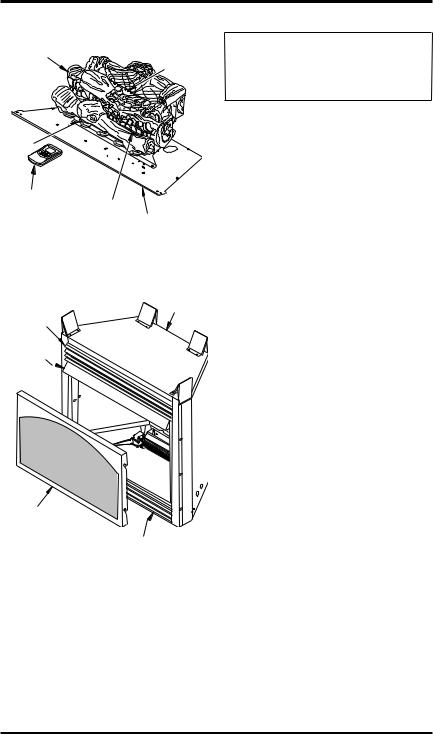
PRODUCT
IDENTIFICATION
Log Set |
Rear |
|
Burner |
Piezo
Ignitor
Optional
Remote
Control
Front
Burner Base
Assembly
Figure 1 - Log Base Assembly
(VSGF36NRA Shown)
UNPACKING
 CAUTION: Do not remove the data plates attached to the heater base assembly. The data plates contain
CAUTION: Do not remove the data plates attached to the heater base assembly. The data plates contain
1.With utility knife, cut the carton all the way around above the staples on the bottom tray. Liftthecartonofftheheater.Removepacking. Note: The hood is located on top of fireplace in a carton.
2.Locate one screw above top left corner of the fireplacescreen.Removeanddiscardscrew.Lift fireplace screen up and pull out to remove.
3.Remove protective packaging applied to logs, log base assembly and fireplace.
4.Check all items for any shipping damage. If damaged, promptly inform dealer where you bought fireplace.
|
Top Outer |
Top Louver |
Casing |
|
|
Assembly |
|
Fireplace |
|
Hood |
|
Screen
Assembly
Bottom Louver
Assembly
Figure 2 - Fireplace (VSGF36NRA Shown)
PRODUCT FEATURES
OPERATION
Thisvent-freefireplaceiscleanburning.Itrequires no outside venting. There is no heat loss out a vent or up a chimney. Heat is generated by both realistic flamesandglowingembers.Whenusedwithoutthe blower, the fireplace requires no electricity making it ideal for emergency backup heat.
SAFETY DEVICE
ThisfireplacehasapilotwithanOxygenDepletion Sensing (ODS) safety shutoff system. The ODS/ pilot is a required feature for vent-free room heaters. The ODS/pilot system shuts off the fireplace if there is not enough fresh air.
PIEZO IGNITION SYSTEM
This fireplace has a piezo ignitor. This system requires no matches, batteries or other sources to light fireplace.
OPTIONAL REMOTE CONTROL ACCESSORY
There are four optional remote controls (not included) that can be purchased separately for this log heater:
•wall switch
•wall thermostat
•hand-held ON/OFF remote
•hand-held thermostat remote See Accessories, page 31.
116746-01A |
www.desatech.com |
5 |
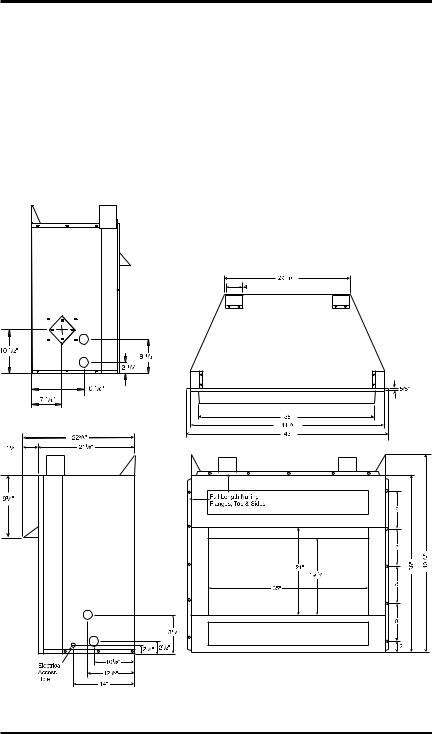
LOCATING FIREBOX
PLANNING
Plan where you will install the firebox.This will save time and money later when you install the firebox. Before installation, consider the following:
1.Where the firebox will be located. Allow for wall and ceiling clearances (see Installation Clearances, page 10).
2.Everything needed to complete installation.
3.These models CANNOT be installed in a bedroom unless the maximum Btu rating of the installed vent-free log set is less than 10,000 Btu/hr.
4.Proper air for combustion and ventilation (page 7).
PRODUCT SPECIFICATIONS
Left Side View
Firebox Top View
Right Side View
Front View
Figure 3 - Firebox Dimensions
6 |
www.desatech.com |
116746-01A |

AIR FOR COMBUSTION AND VENTILATION
 WARNING:Thisfireboxshall not be installed in a confined space or unusually tight construction unless provisions are provided for adequate combustionandventilationair.Readthe following instructions to insure proper fresh air for this and other fuel-burning appliances in your home.
WARNING:Thisfireboxshall not be installed in a confined space or unusually tight construction unless provisions are provided for adequate combustionandventilationair.Readthe following instructions to insure proper fresh air for this and other fuel-burning appliances in your home.
Todayʼs homes are built more energy efficient than ever. New materials, increased insulation and new construction methods help reduce heat loss in homes. Home owners weather strip and caulk around windows and doors to keep the cold air out and the warm air in. During heating months, home owners want their homes as airtight as possible.
While it is good to make your home energy efficient, your home needs to breathe. Fresh air must enter your home.All fuel-burning appliances need fresh air for proper combustion and ventilation.
Exhaust fans, fireboxes, clothes dryers and fuel burning appliances draw air from the house to operate. You must provide adequate fresh air for these appliances. This will insure proper venting of vented fuel-burning appliances.
PROVIDING ADEQUATE VENTILATION
The following are excerpts from National Fuel Gas Code, ANSI Z223.1/NFPA 54, Section 5.3, Air for Combustion and Ventilation.
All spaces in homes fall into one of the three following ventilation classifications:
1.Unusually Tight Construction
2.Unconfined Space
3.Confined Space
The information on pages 7 through 9 will help you classify your space and provide adequate ventilation.
Unusually Tight Construction
The air that leaks around doors and windows may provide enough fresh air for combustion and ventilation. However, in buildings of unusually tight construction, you must provide additional fresh air.
Unusually tight construction is defined as construction where:
a.walls and ceilings exposed to the outside atmosphere have a continuous water vapor retarder with a rating of one perm (6 x 10-11 kg per pa-sec-m2) or less with openings gasketed or sealed and
b.weather stripping has been added on openable windows and doors and
c.caulking or sealants are applied to areas such as joints around window and door frames, between sole plates and floors, between wall-ceiling joints, between wall panels, at penetrations for plumbing, electrical and gas lines and at other openings.
If your home meets all of the three criteria above, you must provide additional fresh air. See Ventilation Air From Outdoors, page 9.
If your home does not meet all of the three criteria above, proceed to Determining Fresh-Air Flow for Heater Location, page 8.
Confined and Unconfined Space
The National Fuel Gas Code, ANSI Z223.1/NFPA 54 defines a confined space as a space whose volume is less than 50 cubic feet per 1,000 Btu per hour (4.8 m3 per kw) of the aggregate input rating of all appliances installed in that space and an unconfined space as a space whose volume is not less than 50 cubic feet per 1,000 Btu per hour (4.8 m3 per kw) of the aggregate input rating of all appliances installed in that space. Rooms communicating directly with the space in which the appliances are installed*, through openings not furnished with doors, are considered a part of the unconfined space.
* Adjoining rooms are communicating only if therearedoorlesspassagewaysorventilationgrills between them.
116746-01A |
www.desatech.com |
7 |
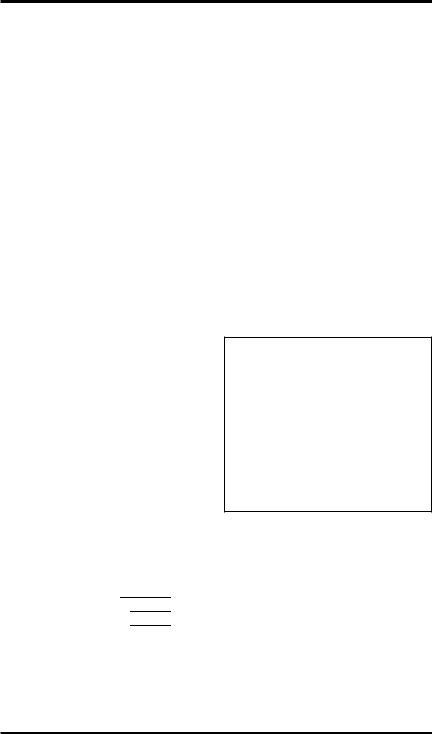
AIR FOR COMBUSTION
AND VENTILATION
Continued
DETERMINING FRESH-AIR FLOW FOR HEATER LOCATION
Determining if You Have a Confined or Unconfined Space
Use this work sheet to determine if you have a confined or unconfined space.
Space: Includes the room in which you will install heater plus any adjoining rooms with doorless passageways or ventilation grills between the rooms.
1.Determine the volume of the space (length x width x height).
Length x Width x Height =__________cu. ft. (volume of space)
Example: Space size 22 ft. (length) x 18 ft. (width) x 8 ft. (ceiling height) = 3168 cu. ft. (volume of space)
If additional ventilation to adjoining room is supplied with grills or openings, add the volume of these rooms to the total volume of the space.
2.Multiply the space volume by 20 to determine the maximum Btu/Hr the space can support.
__________ (volume of space) x 20 = (Maximum Btu/Hr the space can support)
Example: 3168 cu. ft. (volume of space) x 20 = 63,360 (maximum Btu/Hr the space can support)
3.Add the Btu/Hr of all fuel burning appliances in the space.
Vent-free fireplace |
___________ Btu/Hr |
Gas water heater* |
___________ Btu/Hr |
Gas furnace |
___________ Btu/Hr |
Vented gas heater |
___________ Btu/Hr |
Gas fireplace logs |
___________ Btu/Hr |
Other gas appliances* |
+__________ Btu/Hr |
Total |
=__________ Btu/Hr |
* Do not include direct-vent gas appliances. Di- rect-ventdrawscombustionairfromtheoutdoors and vents to the outdoors.
Example: |
|
|
|
Gas water heater |
|
40,000 |
Btu/Hr |
Vent-free fireplace |
+ |
39,000 |
Btu/Hr |
Total |
= |
79,000 |
Btu/Hr |
4.Compare the maximum Btu/Hr the space can support with the actual amount of Btu/Hr used.
_________Btu/Hr(maximumthespacecansupport)
_________Btu/Hr (actual amount of Btu/Hr used)
Example: 63,360 Btu/Hr (maximum the space can support)
79,000 Btu/Hr (actual amount of Btu/Hr used)
The space in the above example is a confined space because the actual Btu/Hr used is more than the maximum Btu/Hr the space can support.You must provide additional fresh air. Your options are as follows:
A.Reworkworksheet,addingthespaceofanadjoiningroom.Iftheextraspaceprovidesanunconfined space, remove door to adjoining room or add ventilation grills between rooms. See Ventilation Air From Inside Building, page 9.
B.Vent room directly to the outdoors. See Ventilation Air From Outdoors, page 9.
C.Install a lower Btu/Hr fireplace, if lower Btu/Hr size makes room unconfined.
If the actual Btu/Hr used is less than the maximum Btu/Hr the space can support, the space is an unconfined space. You will need no additional fresh air ventilation.
 WARNING:Iftheareainwhich the heater may be operated is smaller than that defined as an unconfined space or if the building is of unusually tight construction, provide adequate combustion and ventilation air byoneofthemethodsdescribed in the National Fuel Gas Code, ANSIZ223.1/NFPA54Section5.3 or applicable local codes.
WARNING:Iftheareainwhich the heater may be operated is smaller than that defined as an unconfined space or if the building is of unusually tight construction, provide adequate combustion and ventilation air byoneofthemethodsdescribed in the National Fuel Gas Code, ANSIZ223.1/NFPA54Section5.3 or applicable local codes.
8 |
www.desatech.com |
116746-01A |

AIR FOR COMBUSTION
AND VENTILATION
Continued
VENTILATION AIR
Ventilation Air From Inside Building
This fresh air would come from an adjoining unconfined space. When ventilating to an adjoining unconfined space, you must provide two permanent openings: one within 12" of the ceiling and one within 12" of the floor on the wall connecting the two spaces (see options 1 and 2, Figure 4).You can also remove door into adjoining room (see option 3, Figure 3). Follow the National Fuel Gas Code, ANSI Z223.1/NFPA 54, Section 5.3, Air for Combustion and Ventilation for required size of ventilation grills or ducts.
|
|
12" |
|
Ventilation |
|
Ventilation Grills |
|
Grills |
|
||
Into |
Or |
Into Adjoining Room, |
|
Adjoining |
Option 2 |
||
Remove |
|||
Room, |
|
||
Door into |
|
||
Option 1 |
|
||
Adjoining |
|
||
|
|
||
|
Room, |
|
|
|
Option |
|
|
|
3 |
|
|
|
|
12" |
Figure 4 - Ventilation Air from Inside Building
Ventilation Air From Outdoors
Provideextrafreshairbyusingventilationgrillsor ducts.You must provide two permanent openings: one within 12" of the ceiling and one within 12" of the floor. Connect these items directly to the outdoors or spaces open to the outdoors. These spaces include attics and crawl spaces. Follow the
National Fuel Gas Code, ANSI Z223.1/NFPA 54, Section 5.3,Air for Combustion and Ventilation for required size of ventilation grills or ducts.
IMPORTANT: Do not provide openings for inlet or outlet air into attic if attic has a thermostatcontrolledpowervent.Heatedairenteringtheattic will activate the power vent.
|
Outlet |
Ventilated |
|
Attic |
|
|
Air |
|
|
|
|
Outlet |
|
|
Air |
|
To Attic |
|
|
|
|
|
To |
|
|
Crawl |
Inlet |
|
Space |
|
|
|
Air |
|
|
|
Inlet Air |
Ventilated |
|
Crawl Space |
|
|
|
Figure 5 - Ventilation Air from Outdoors
INSTALLATION
NOTICE:Thisheaterisintended for use as supplemental heat. Use this heater along with your primary heating system. Do not install this heater as your primary heat source. If you have a centralheatingsystem,youmay run system’s circulating blower whileusingheater.Thiswillhelp circulatetheheatthroughoutthe house. In the event of a power outage, you can use this heater as your primary heat source.
 WARNING:Aqualifiedservice person must install fireplace. Follow all local codes.
WARNING:Aqualifiedservice person must install fireplace. Follow all local codes.
 WARNING: Never install the fireplace
WARNING: Never install the fireplace
•in a bedroom or bathroom
•in a recreational vehicle
•where curtains, furniture, clothing or other flammable objectsarelessthan42inches from the front, top or sides of the heater
•in high traffic areas
•in windy or drafty areas
116746-01A |
www.desatech.com |
9 |
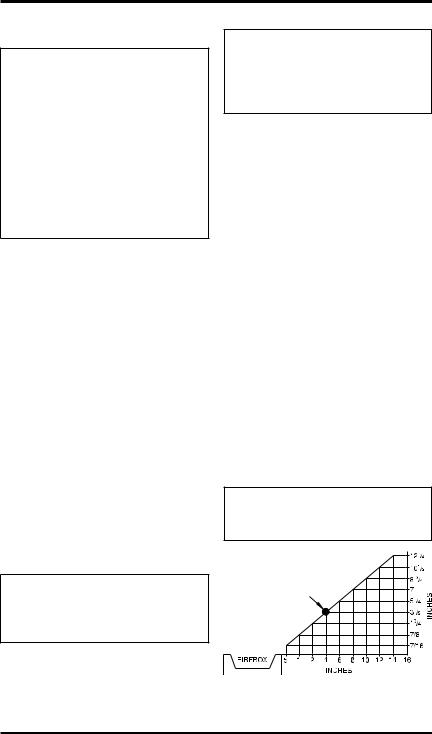
INSTALLATION
Continued
 CAUTION:Thisfireplacecreates warm air currents. These currents move heat to wall surfacesnexttofireplace.Installing fireplace next to vinyl or cloth wall coverings or operating heater where impurities (such as, but not limited, to tobacco smoke,aromaticcandles,cleaningfluids,oilorkerosenelamps, etc.)intheairexist,maydiscolor walls or cause odors.
CAUTION:Thisfireplacecreates warm air currents. These currents move heat to wall surfacesnexttofireplace.Installing fireplace next to vinyl or cloth wall coverings or operating heater where impurities (such as, but not limited, to tobacco smoke,aromaticcandles,cleaningfluids,oilorkerosenelamps, etc.)intheairexist,maydiscolor walls or cause odors.
Note:Your fireplace is designed to be used in zero clearance installations. Wall or framing material can be placed directly against any exterior surface on the rear, sides or top of your fireplace, except where standoff spacers are integrally attached. If standoff spacers are attached to your fireplace, these spacers can be placed directly against wall or framing materials.
Use the dimensions shown for rough openings to create the easiest installation. See Built-In Fireplace Installation, page 11.
IMPORTANT: Vent-free heaters add moisture to the air. Although this is beneficial, installing fireplace in rooms without enough ventilation air may causemildewtoformfromtoomuchmoisture.See
Air for Combustion and Ventilation, page 7.
IMPORTANT: Make sure the fireplace is level. If fireplace is not level, log set will not work properly.
CHECK GAS TYPE
Use the correct gas type (natural or propane/LP) for your fireplace. If your gas supply is not correct, do not install fireplace. Call dealer where you bought fireplace for proper type fireplace.
 WARNING: This appliance is equipped for (natural or propane/LP) gas. Field conversion is not permitted.
WARNING: This appliance is equipped for (natural or propane/LP) gas. Field conversion is not permitted.
INSTALLATION CLEARANCES
 WARNING: Maintain the minimum clearances. If you can, provide greater clearances fromfloor,ceilingandadjoining wall.
WARNING: Maintain the minimum clearances. If you can, provide greater clearances fromfloor,ceilingandadjoining wall.
Carefully follow the instructions below. This will ensure safe installation.
Minimum Wall and Ceiling Clearances (see Figure 6)
A.Clearances from the side of the fireplace cabinet to any combustible material and wall should follow diagram in Figure 6.
Example: The face of a mantel, bookshelf, etc. is made of combustible material and protrudes 3 1/2" from the wall. This combustible material must be 4" from the side of the fireplace cabinet (see Figure 6).
B.Clearances from the top of the firebox opening to the ceiling should not be less than 42 inches.
C.When the firebox is installed on carpeting or other combustible material, other than wood flooring, the firebox should be installed on a metal or wood panel extending the full width and depth of the enclosure.
D.Clearances from the bottom of firebox to the floor is 0 inches.
These fireboxes can be installed as freestanding units against a wall with the approved, optional cabinet mantels (see Accessories, page 31) or as a built-inunit.Theclearancesarethesameforeither installation method.
 CAUTION: Do not install the firebox directly on carpet or vinyl.
CAUTION: Do not install the firebox directly on carpet or vinyl.
Example |
* |
*Minimum 16 inches from Side Wall
Figure 6 - Minimum Clearance for Combustible to Wall
10 |
www.desatech.com |
116746-01A |
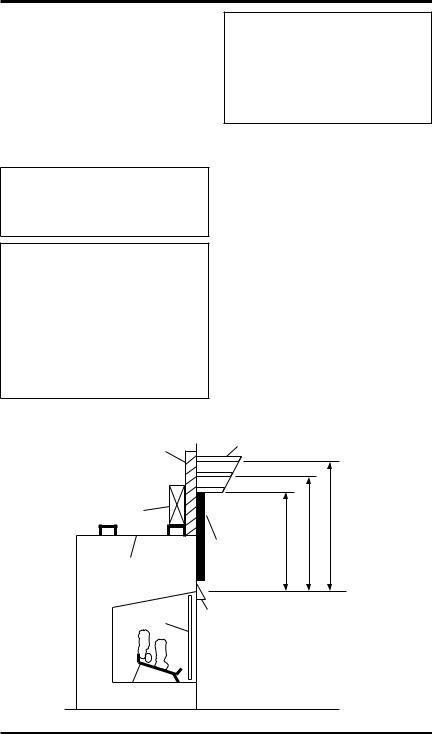
INSTALLATION
Continued
Mantel Clearances for Built-In Installation
If placing custom mantel above built-in firebox, you must meet the minimum allowable clearance between mantel shelf and top of firebox opening showninFigure7.Thesearetheminimumallowable mantel clearances for a safe installation. Use larger clearances wherever possible to minimize the heating of objects and materials placed on the mantel.
 CAUTION: Do not allow the vent-freegaslogheatertotouch or extend beyond the fireplace screen.
CAUTION: Do not allow the vent-freegaslogheatertotouch or extend beyond the fireplace screen.
NOTICE: Surface temperatures ofadjacentwallsandmantelsbecomehotduringoperation.Walls and mantels above the firebox may become hot to the touch. If installed properly, these temperatures meet the requirement ofthenationalproductstandard. Follow all minimum clearances shown in this manual.
NOTICE: If your installation does notmeettheminimumclearances shown, you must do one of the following:
•raise the mantel to an acceptable height
•remove the mantel
BUILT-IN FIREBOX INSTALLATION
Built-ininstallationofthisfireboxinvolvesinstall- ing firebox into a framed-in enclosure.This makes the front of firebox flush with wall. Optional brass trim accessories are available (see Accessories, page 31). The brass trim will extend past sides of firebox approximately 1/2 inch. This will cover the rough edges of the wall opening. If installing a mantel above the firebox, you must follow the clearances shown in Figure 6, page 10. Follow the instructions below to install the firebox in this manner.
Wall board or facing material (above firebox) may be of combustible material, including decorative mantel ornaments or other similar projections off of the facing material.
Framing
Material
Firebox
Wire-mesh
Screen
Mantel Shelf
Note: Any portion of the mantel shelf must NOT
extend beyond this profile.
12"
63/4"
11/2"
Noncombustible Material May
Project Off this 12" 16" 20" Surface above
the Firebox Hood
|
Note: All vertical |
|
Supplied Firebox |
measurements are |
|
from top of fireplace |
||
Hood Must Be |
||
hood opening to |
||
Used at All Times |
||
bottom of mantel shelf. |
||
|
||
|
These minimum |
|
|
clearances replace any |
|
|
other recommended |
|
|
clearances supplied with |
|
|
your ANSI Z21.11.2 |
|
|
approved gas logs. |
Figure 7 - Minimum Mantel Clearances for Built-In Installation
116746-01A |
www.desatech.com |
11 |
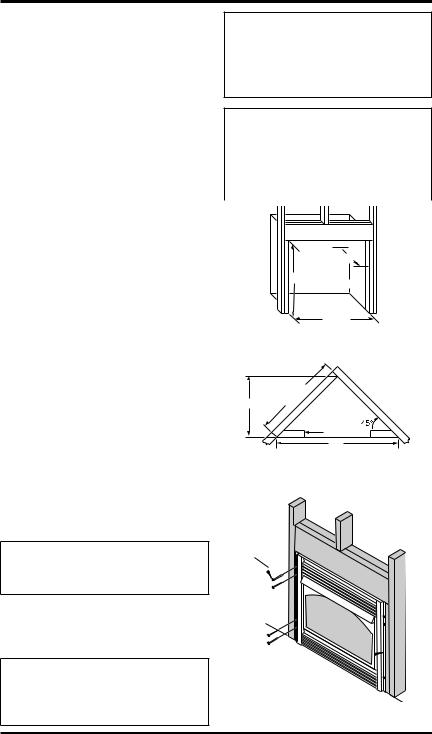
INSTALLATION
Continued
1.Frame in rough opening. The firebox framing shouldbeconstructedof2x4lumberorheavier. Use dimensions in Table 1 and rough opening layoutinFigure8.Adjustframingsothatfirebox flushes with finished wall surface. If installing in a corner, use dimensions in Figures 8 and 9 for rough opening.
2.Installgaspipingtofireboxlocation.SeeInstalling GasPipingtoFireplaceLocationonpage13and Connecting Fireplace to Gas Supply, page 15.
IMPORTANT: If installing blower accessory (circulating models with louvers only), see HardWiring Firebox, page 18.
3.Carefully set firebox in front of rough opening with back of firebox inside wall opening. IMPORTANT: If installing a perimeter trim kit, see instructions included with trim accessory. You must install shoulder screws from trim kit now.
4.Carefully insert firebox into rough opening.
5.Attach firebox to wall studs using nails or wood screws through holes in nailing flange (see Figure 10).
6.If using an optional perimeter trim kit, install the trim after final finishing and/or painting of wall. See instructions included with trim accessory for attaching trim.
7.Install and properly test gas log heater. Follow installation instructions included with the vent-free gas log heater that is being installed.
IMPORTANT: When finishing your firebox, combustible materials such as wall board, gypsum board, sheet rock, drywall, plywood, etc. may be butted up next to the sides and top of the firebox. Combustible materials should never overlap the firebox front facing.
 WARNING: Do not allow any combustiblematerialstooverlap the firebox front facing.
WARNING: Do not allow any combustiblematerialstooverlap the firebox front facing.
IMPORTANT:Noncombustible materials such as brick, tile, etc. may overlap the front facing, but should never cover any necessary openings like louvered slots.
 WARNING: Do not allow noncombustible materials to cover any necessary openings like louvered slots.
WARNING: Do not allow noncombustible materials to cover any necessary openings like louvered slots.
 WARNING:Useonlynoncombustible mortar or adhesives when overlapping the front facing with noncombustible facing material.
WARNING:Useonlynoncombustible mortar or adhesives when overlapping the front facing with noncombustible facing material.
Rough Opening Dimensions for Built-in Installation
|
Front Width |
|
|
|
(Inside to |
|
Depth |
Model |
Inside) |
Height |
(Minimum) |
|
|
|
|
36" |
41 1/2" |
40 1/2" |
20 3/4" |
Depth
 (Minimum)
(Minimum)
Height
Width (InsidetoInside)
Figure 8 - Rough Opening for Installing in Wall
|
|
" |
|
|
/32 |
|
|
11 |
37" |
2 |
|
5 |
|
|
411/2" 

74"
TOP VIEW
Figure 9 - Rough Opening for Installing in Corner Wall
Nails or
Wood
Screws
Nailing 

Flange
Figure 10 - Attaching Firebox to Wall Studs
12 |
www.desatech.com |
116746-01A |
